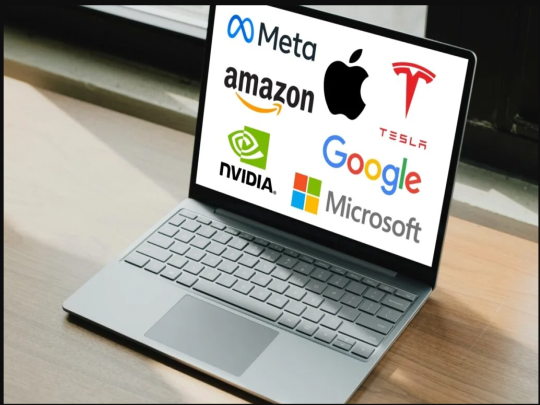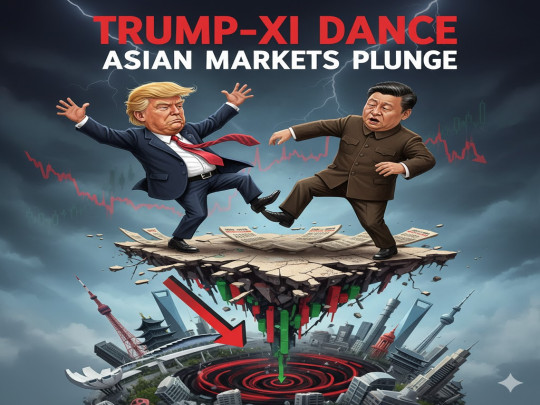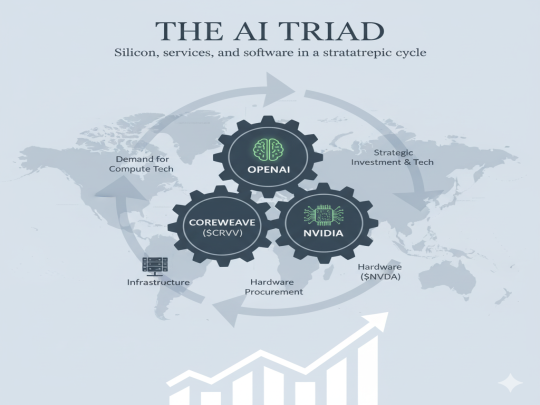Morning Market Brief: Court Blocks Trump’s Reciprocal Tariffs, Nvidia Earnings Boost Tech Stocks
Morning Market Update: Stock futures rose after a federal court blocked Trump’s reciprocal tariffs. NVIDIA's strong earnings fueled gains across the semiconductor sector. Tesla's shares climbed as Musk leaves DOGE.

- Early Thursday US stock futures surged, driven by a federal trade court striking down President Trump’s “reciprocal tariffs” late Wednesday and a strong earnings report from Nvidia.
- The rally contributes to a strong May for markets (S&P +5.7% MTD, Nasdaq +9.5% MTD), fueled by hopes of easing trade tensions and AI excitement, despite Wednesday's dip.
- Wednesday saw US stocks close lower (S&P -0.56%), with markets reacting to cautious Federal Reserve minutes and a spike in the 30-year Treasury yield, which briefly hit 5%.
- Wednesday's trading featured Okta tumbling over 16% as its maintained guidance disappointed, while Abercrombie & Fitch (+14%) and Dick's Sporting Goods (+2%) rallied on strong earnings.
- Significant premarket movers Thursday included Nvidia (+5.6%-6%) soaring on a strong Q1 beat (EPS $0.96, Rev $44.06B) driven by AI chip stockpiling. Other chip stocks (Marvell, AMD) rallied. Tesla (+2.2%) gained as Musk confirmed leaving his government role. Tariff-exposed stocks (Nike, Dollar Tree) advanced on the court ruling. C3.ai (+13%-14%) jumped on earnings. Best Buy (-2.1%) and HP (-10%) fell on guidance/results.
- Regarding tariffs, a US federal trade court struck down Trump’s “reciprocal tariffs” Wednesday evening, ruling he exceeded authority and ordering a permanent halt; the administration is appealing. Specific product tariffs (steel/aluminum) are unaffected.
- Federal Reserve minutes released Wednesday revealed increasing official concern that Trump's tariffs could exacerbate inflation and complicate policy, leading to a cautious approach.
- Company earnings included Nvidia beating Q1 estimates, though CEO Huang noted significant impact from US export restrictions on chips to China. Tesla's Musk confirmed his departure from a government role. Best Buy cut its FY26 outlook due to tariffs.
- Global markets rallied Thursday, with Europe and Asia advancing on the US court's tariff ruling and Nvidia's strong earnings. The Bank of Korea also cut its interest rate.
- US Treasury yields, which rose Wednesday (30-year briefly above 5%) on Fed minutes, are expected to react to the court's tariff ruling Thursday morning.
- Gold prices rebounded Thursday on haven demand following the court's tariff ruling. Oil prices rose but faced pressure from potential OPEC+ output hikes. Bitcoin saw a slight pullback Wednesday.
- Market sentiment improved sharply Thursday morning, driven by the court's tariff ruling and Nvidia's strong earnings, though underlying caution about trade policy persists. Focus shifts to Q1 GDP data today and PCE inflation Friday.
Stock futures moved higher after a federal trade court struck down President Donald Trump’s proposed “reciprocal tariffs” on Wednesday evening, offering some relief to investors unsettled by the administration’s shifting trade stance. The court’s decision followed weeks of market volatility triggered by Trump's announcement of steep duties on April 2. Contributing to the positive sentiment, Nvidia reported strong quarterly earnings, which boosted investor confidence and helped lift stock futures further.
Earlier in the day, U.S. equities slipped as investors evaluated a batch of corporate earnings and digested the latest minutes from the Federal Reserve’s policy meeting. Treasury yields added to the market’s caution, with the 30-year yield briefly touching 5%, a level that raised concerns about long-term borrowing costs and economic growth.
Despite Wednesday’s pullback, major indexes are on pace to finish both the week and the month with solid gains. The S&P 500 is up 1.5% for the week, the Dow Jones Industrial Average has gained 1.2%, and the Nasdaq Composite has advanced nearly 2%. For the month of May, the S&P 500 has climbed 5.7%, the Dow is up 3.5%, and the Nasdaq has surged 9.5%, bolstered by a 10% rally in the tech sector. Much of the tech strength has been driven by excitement around artificial intelligence developments, particularly from Alphabet. The broader market rebound gained traction after Trump walked back his plan to implement a 50% tariff on the European Union starting June 1, instead postponing the move until July 9.
US Market Previous Day:
U.S. stocks ended lower in the previous session, with all three major indexes closing in the red. The S&P 500 declined 0.56% to finish at 5,888.55, while the Nasdaq Composite lost 0.51% to settle at 19,100.94. The Dow Jones Industrial Average dropped 244.95 points, or 0.58%, closing at 42,098.70.
Among notable movers, Okta shares tumbled more than 16% after the company maintained its full-year guidance despite delivering better-than-expected quarterly results, citing ongoing macroeconomic uncertainty. Meanwhile, Abercrombie & Fitch surged over 14%, and Dick’s Sporting Goods rose nearly 2% following strong earnings reports that reassured investors.
US Futures Remain Flat:
- Dow Jones Industrial Average futures remained flat with decline of 0.2%
- S&P 500 futures showed meagre gains of 0.15%
- Nasdaq Composite futures lead the pack with gains of 0.37%.
Biggest Premarket Movers
- Nvidia: Stock soared approximately 5.6% to 6% after the world’s most valuable semiconductor firm reported first-quarter adjusted earnings of 96 cents per share on revenue of $44.06 billion, beating LSEG analyst expectations of 93 cents and $43.31 billion, respectively. The strong results were attributed to customers stockpiling its AI chips ahead of fresh U.S. curbs on China exports taking effect.
- Tesla: Stock rose 2.2% after CEO Elon Musk confirmed he was leaving his role in the Trump administration. This news was perceived positively by investors, suggesting he can now dedicate more of his focus to running the electric vehicle giant.
- Kohl’s: Stock gained around 3.7% to 6% after the department store chain reported a first-quarter loss of 13 cents per share, which was smaller than the 26-cent loss LSEG analysts had expected. The company also maintained its annual targets as it continues its turnaround efforts and cost-cutting measures. Revenue of $3.05 billion also surpassed the $3.02 billion estimate.
- Best Buy: Stock fell about 2.1% after the electronics retailer slashed its outlook for fiscal 2026, citing the anticipated impact of tariffs. This overshadowed its better-than-expected results for the first quarter, though the company did miss quarterly revenue expectations.
- Salesforce: Stock edged slightly higher (around 0.1%) as the software firm posted fiscal first-quarter results that topped Wall Street expectations and also raised its full-year guidance. Investors also reacted positively to the recently announced $8 billion acquisition of cloud data management firm Informatica.
- C3.ai: Stock soared approximately 13% to 14% after the enterprise artificial intelligence software company reported a better-than-expected quarterly financial report, including a narrower-than-anticipated fiscal fourth-quarter loss of 16 cents per share (versus a 20-cent loss FactSet estimate). Revenue of $108.7 million also exceeded the anticipated $107.8 million.
- Foot Locker: Stock fell 0.1% after the footwear retailer reported first-quarter earnings and revenue that missed expectations, citing softer traffic trends.
- Burlington Stores: Gained around 7% to 8.8% after the retailer reported first-quarter adjusted earnings of $1.67 per share, surpassing the $1.43 FactSet estimate. CEO Michael O’Sullivan noted uncertainty around tariffs but expressed confidence in the company's ability to offset potential margin pressure. Revenue of $2.50 billion was slightly below the $2.53 billion analysts had penciled in.
- Hormel Foods: Stock fell 0.6% after the food processing company reported second-quarter earnings that met expectations, while its revenue came in slightly short of analyst estimates.
- JetBlue Airways, United Airlines: JetBlue stock rose approximately 1% to 4.6% and United Airlines stock gained about 2% to 2.3%. The gains followed the two carriers unveiling plans for a new consumer collaboration called "Blue Sky," which will allow travelers to book flights on both carriers’ websites and interchangeably earn and use points in their respective frequent flyer programs. This partnership will also see United Airlines return to New York’s John F. Kennedy International Airport.
- Other Chip Stocks (Marvell Technology, Broadcom, Advanced Micro Devices, Intel, Taiwan Semiconductor Manufacturer): These stocks rallied in sympathy with Nvidia's strong report. Shares of Marvell Technology surged 5%, Broadcom and Advanced Micro Devices each added 3%, while Intel and Taiwan Semiconductor Manufacturer gained 1%.
- Tariff-exposed stocks (Nike, Deckers Outdoor, Lululemon Athletica, Dollar Tree): Stocks with substantial exposure to tariffs advanced after the U.S. Court of International Trade on Wednesday blocked President Donald Trump’s reciprocal tariffs and ordered the administration to cease their collection. Shares of Nike and Deckers Outdoor rose 2%, while Lululemon Athletica and Dollar Tree added 1%.
- Veeva Systems: The cloud-computing company jumped 14% after its first-quarter adjusted earnings of $1.97 per share and revenue of $759 million topped the $1.74 per share and $728.4 million, respectively, that analysts polled by FactSet had estimated.
- E.l.f. Beauty: The beauty stock soared 9% after its fiscal fourth-quarter earnings and revenue beat analyst estimates. However, the company withheld its full-year outlook due to tariff uncertainty. E.l.f. also announced plans to acquire Rhode, Hailey Bieber’s beauty brand, in a deal worth up to $1 billion. Other cosmetics and skincare stocks like Estée Lauder and Coty rose 2% in tandem, while Ulta Beauty added 1%.
- Agilent Technologies: The life sciences equipment maker added 6% after its fiscal second-quarter revenue and net income beat analysts’ estimates. Agilent also raised its full-year revenue guidance to a range of $6.73 billion to $6.81 billion, up from its previous forecast and above the $6.73 billion FactSet consensus.
- HP: The personal computer maker fell 10% after its second-quarter earnings missed analyst expectations. HP also guided for adjusted earnings in its current quarter to be between 68 cents and 80 cents per share, falling short of the 90-cent average analyst estimate from LSEG.
- SentinelOne: Shares tumbled 13% after the cybersecurity company said its second-quarter revenue would total approximately $242 million, missing the $244.9 million consensus analyst forecast from FactSet. SentinelOne’s full-year revenue guidance also missed consensus estimates.
- Southwest Airlines: Shares popped 2% after Deutsche Bank upgraded the carrier to "buy" from "hold." Analyst Michael Linenberg pointed to Southwest’s refreshed board of directors and current strategic initiatives as catalysts that should drive revenue and improve the company’s return on invested capital.
- Cleveland-Cliffs: The steelmaker was little changed following a downgrade from Jefferies to "hold" from "buy," after the stock slid 7% on Wednesday. The Jefferies analyst suggested that Nippon Steel’s acquisition of U.S. Steel would negatively impact other major U.S. steel producers.
- Synopsys: Shares rallied 4% after a federal court blocked President Donald Trump’s reciprocal tariffs. Earlier, the chip stock had experienced a decline following a Financial Times report that the White House had instructed U.S. semiconductor companies to cease selling to customers in China.
Tariff Update:
A three-judge panel from the U.S. Court of International Trade dealt a significant blow to President Donald Trump’s trade agenda on Wednesday evening by ruling that he exceeded his authority in unilaterally imposing reciprocal tariffs. The court found that the 1977 law Trump used to justify the sweeping tariffs does not grant him such power, and it ordered a permanent halt to the duties while also barring any future modifications. The ruling applies to reciprocal tariffs Trump imposed on more than 180 countries and territories, as well as additional tariffs against Canada, Mexico, and China tied to drug trafficking concerns. However, tariffs on specific products like aluminum and steel are unaffected. The administration has ten days to comply with the court’s ruling, though it has already filed an appeal.
The U.S. Court of International Trade determined that the International Emergency Economic Powers Act does not authorize a president to enact universal duties on imports. The court further stated that the tariffs connected to drug-related issues with Canada, Mexico, and China do not sufficiently address the specific threats outlined in the executive orders. As a result, the court issued a permanent injunction against the tariffs at the center of the case.
This legal development temporarily reassured investors, helping to ease recent market anxiety around escalating trade tensions. However, it also raises concerns that U.S. trade negotiations could drag on longer than expected, potentially pushing substantive deals further into the year. According to Goldman Sachs, the Trump administration is likely to appeal the ruling and may turn to alternative legal tools, such as Section 301 of the Trade Act of 1974, to reimpose the tariffs. This statute was previously used by Trump to justify tariffs on China during his first term. Still, Goldman noted that while the administration might succeed in reinstating some duties, a broad reapplication of the “Liberation Day” tariffs is unlikely.
On Wednesday, Trump dismissed a theory circulating among market watchers known as the “TACO theory” — short for “Trump Announces, Crashes, Opts-out.” The theory describes a pattern in which Trump proposes aggressive tariff measures that roil markets, only to later soften or delay them, sparking market rebounds. When questioned about the theory, Trump said his actions are “called negotiation.”
Key Economic Data/News:
Minutes from the Federal Reserve’s meeting earlier this month revealed that officials are increasingly concerned that President Donald Trump’s tariffs could exacerbate inflation and complicate the central bank’s policy decisions. The discussion, released Wednesday, reflected a consensus among participants that the evolving government policy landscape — particularly trade-related measures — had heightened uncertainty around the economic outlook, prompting a cautious stance. “Participants agreed that uncertainty about the economic outlook had increased further, making it appropriate to take a cautious approach until the net economic effects of the array of changes to government policies become clearer,” the minutes stated.
At the meeting, the Fed opted to keep its benchmark interest rate unchanged in the 4.25% to 4.5% range, where it has remained since December. Officials emphasized that the current rate level allows them flexibility to monitor incoming data before adjusting policy. Despite concerns about inflation and trade, the minutes also noted that economic growth remains “solid,” the labor market is “broadly in balance,” and consumer spending continues to support demand. However, policymakers acknowledged that risks to the labor market and broader economy could increase if inflation pressures persist or trade tensions escalate further.
Earnings Season/Company News:
Nvidia surpassed Wall Street’s expectations on both revenue and earnings for the first quarter, driven by a 73% year-over-year surge in data center sales. The company reported adjusted earnings of 96 cents per share on $44.06 billion in revenue, beating analyst forecasts of 93 cents per share and $43.31 billion in revenue, according to LSEG. Despite issuing a current-quarter sales forecast of $45 billion — slightly below estimates — CEO Jensen Huang highlighted that guidance would have been $8 billion higher if not for losses related to U.S. export restrictions on its H20 chips. Huang underscored the impact of these curbs on China, noting that the "$50 billion China market is effectively closed to U.S. industry." The results boosted Nvidia shares by nearly 5% in Thursday morning trading and sparked gains across global semiconductor stocks.
Tesla shares also traded higher in premarket action after CEO Elon Musk confirmed he was stepping down from his role in the U.S. government this week, complying with restrictions on special government employees. The move comes amid growing investor unease about Musk's divided focus, especially with Tesla grappling with declining European sales, intensifying competition, and a sliding stock price. On Wednesday, a group of major pension fund investors sent a letter to Tesla board chair Robyn Denholm, calling for Musk to commit to a minimum 40-hour workweek at Tesla before any new compensation package is considered. The group cited “declining sales” and a “plummeting global reputation” as pressing concerns tied to Musk's external commitments.
Meanwhile, Best Buy missed quarterly revenue expectations and lowered its full-year sales and profit guidance, citing the impact of higher tariffs on electronics pricing. The retailer now projects fiscal 2026 revenue between $41.1 billion and $41.9 billion, down from its previous outlook of $41.4 billion to $42.2 billion. It also reduced its adjusted earnings forecast to a range of $6.15 to $6.30 per share, compared to prior guidance of $6.20 to $6.60. CFO Matt Bilunas noted that the updated outlook assumes current tariff levels remain and that consumer behavior will not materially deviate from recent trends.
Global Market Trends:
European equity markets mostly advanced on Thursday, buoyed by relief over a U.S. federal court ruling that blocked President Donald Trump’s proposed reciprocal trade tariffs. The decision eased investor concerns about potential economic fallout from escalating trade measures. The pan-European STOXX 600 index edged 0.2% higher, extending recent gains driven by improving sentiment. Germany’s DAX 40 rose 0.4%, nearing record territory, while France’s CAC 40 added 0.6%. The U.K.’s FTSE 100 posted a more modest gain of 0.1%. AI-related stocks in Europe, such as ASML and Schneider Electric, outperformed amid positive momentum from Nvidia’s strong earnings report. The STOXX 600 has now climbed 4.4% so far in May as trade tensions have cooled.
In Asia, markets also traded mostly higher on Thursday in reaction to the U.S. court decision curbing Trump’s tariff powers. South Korea’s Kospi jumped 1.89% to close at 2,720.64, while the Kosdaq gained 1.03% to end at 736.29. The Bank of Korea cut its benchmark interest rate from 2.75% to 2.5%, marking the lowest level since August 2022 and aligning with expectations. Japan’s Nikkei 225 climbed 1.88% to finish at 38,432.98, while the broader Topix rose 1.53% to 2,812.02. Australia’s S&P/ASX 200 edged up 0.15% to 8,409.8. Hong Kong’s Hang Seng Index gained 1.35% to 23,573.38, and China’s CSI 300 rose 0.59% to 3,858.70. Investor attention remained focused on Asian chipmakers following Nvidia’s robust results, which highlighted a 73% year-over-year increase in its data center segment, reinforcing optimism around AI-related growth.
Debt Market:
U.S. Treasury yields advanced on Wednesday, May 28, 2025, with the 30-year bond rate notably touching above a key psychological level, as investors analyzed the minutes from the Federal Reserve’s policy meeting held earlier in May.
The 30-year Treasury yield rose by 4 basis points to settle at 4.983%, after briefly trading above the 5% mark during the session. The benchmark 10-year Treasury yield was approximately 5 basis points higher, closing around 4.485%. Meanwhile, the 2-year Treasury yield added nearly 5 basis points to reach 3.996%.
Commodities and Other Assets:
Gold rebounded Thursday after early-session weakness, lifted by dip-buying and safe-haven demand following the U.S. federal trade court’s ruling against President Trump’s reciprocal tariffs. The yellow metal had briefly touched a more than one-week low before regaining ground, as geopolitical and trade-related uncertainties — especially surrounding Trump’s policy direction in 2025 — continue to support haven flows. Investor focus now shifts to upcoming U.S. inflation data, which could further influence gold’s trajectory. Gold has hit multiple record highs this year amid persistent macroeconomic and geopolitical volatility.
Oil prices rose but gave up some earlier gains. Brent crude climbed as high as $65.50 during the session on concerns about potential new U.S. sanctions against Russia, which could curb supply. However, upside momentum was capped by the prospect of a production hike from eight key OPEC+ members — including Russia and Saudi Arabia — who are considering adding up to 411,000 barrels per day in July. These producers have been gradually unwinding voluntary production cuts and are scheduled to finalize their July output plan on May 31. The group had implemented two layers of production cuts, one of which (1.66 million bpd) extends into 2026, while another (2.2 million bpd) is being gradually phased out in Q2 2025.
Bitcoin (BTC) declined 2% over the past 24 hours amid a pause in broader market momentum and ahead of the release of Federal Reserve meeting minutes. The flagship cryptocurrency briefly dipped 2.7% on Wednesday, falling from a $110,000 daily open to a low of $107,107. Despite this pullback, Bitcoin remains up approximately 15% over the past month and recently set a new all-time high of $111,953. Since then, BTC has traded sideways, holding within a $106,800 to $109,700 range. Market participants are watching closely for signs of increased volatility, particularly as macroeconomic data and central bank policy updates loom.
Market Sentiment:
Market sentiment remains cautiously optimistic but clouded by uncertainty surrounding trade policy and upcoming economic data. According to a Tuesday note from UBS, trade deal volatility is expected to be a dominant market theme this year, especially given President Trump's aggressive negotiating style. The bank cautions that further episodes of volatility are likely, particularly as the U.S. continues trade talks with major partners including China and the European Union.
UBS also noted that with the S&P 500 now just 4% below its February record high, the potential for additional upside this year may be limited. Investors are increasingly aware that headline risk from trade developments could disrupt momentum.
Attention now turns to key economic data releases later this week, which could provide further direction for markets. The U.S. GDP growth rate for Q1 is due Thursday morning, while Friday’s release of the Personal Consumption Expenditures (PCE) index — the Federal Reserve’s preferred inflation gauge — will be closely scrutinized for signals on inflation and the broader economic outlook. These data points may influence both market expectations for interest rates and short-term equity performance.



